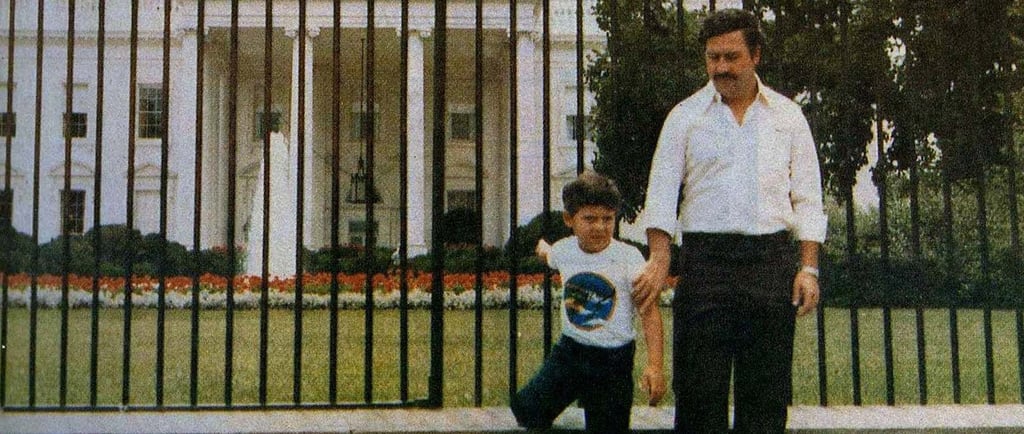The Day Pablo Escobar Took a Family Photo Outside the White House
In the annals of criminal history, few figures have commanded the level of power, wealth, and audacity as Pablo Escobar, the notorious Colombian drug lord who ruled the global cocaine trade in the 1980s. But among the many chilling and outrageous episodes in his life, one moment stands out for its sheer brazenness: Escobar, while already under suspicion by U.S. authorities, once posed for a casual tourist photo right outside the White House—with his young son by his side. It wasn’t just a family snapshot. It was a statement, one that revealed Escobar’s dangerous confidence and the staggering gaps in international enforcement at the time.
BILLIONAIRE
Thrivevision
5/28/20253 min read


A Criminal on Vacation
The photograph in question was taken around 1981, a time when Escobar was already amassing vast wealth and power as the head of the Medellín Cartel, which would go on to control up to 80% of the global cocaine trade. By this time, the cartel’s product had flooded American streets, and the DEA was increasingly aware of the growing Colombian threat.
And yet, Pablo Escobar—arguably one of the most dangerous men alive—managed to enter the United States with no resistance.
Standing on Pennsylvania Avenue, just outside the White House fence, Escobar is captured in the photo smiling alongside his young son, Juan Pablo Escobar (now Sebastián Marroquín), wearing jeans and a light blue shirt. Behind him, one of the most secure buildings in the world. In front of him, a future he thought he could control.
How Did He Do It?
At the time, Escobar was not yet a household name outside Colombia. While U.S. law enforcement had growing intelligence on Colombian drug smuggling operations, Escobar’s full identity and global reach were not yet completely understood. He had not yet been indicted in the United States, and his cartel operated under the radar internationally.
With millions in laundered money and access to forged documents, it's likely Escobar entered the U.S. under a false identity or through connections that ensured a smooth arrival. The ease with which he crossed borders reflected not only his network’s power but also the lack of global coordination among law enforcement agencies in the pre-digital era.
More Than a Photo: A Symbol of Arrogance
To many who have studied Escobar’s life, this photo is not just a curiosity—it’s a symbolic moment. Escobar didn’t just run a drug empire; he saw himself as untouchable, even messianic. He was known to build housing for the poor, fund churches, and give money to Colombia’s impoverished communities in exchange for loyalty. At the same time, he ordered assassinations, bombings, and the murder of politicians, judges, and journalists.
So, standing in front of the White House—the epicenter of the country trying to dismantle him—was his way of silently declaring: “You can’t catch me.”
It was a moment of psychological warfare, and a testament to the impunity he felt. The fact that this image exists, untouched by time, still sends chills down the spine of historians and law enforcement alike.
The Fall That Followed
Of course, Escobar’s empire would not last. The U.S. and Colombian governments eventually intensified efforts to take down the Medellín Cartel. A violent manhunt culminated in Escobar’s death in 1993, shot by police on a Medellín rooftop after years of bloodshed, betrayals, and relentless pursuit.
But in the years between that family photo and his final moments, Escobar wreaked havoc on Colombia and left a trail of violence that scarred a nation. He bombed a commercial airplane, assassinated a presidential candidate, and turned Medellín into one of the deadliest cities in the world.
A Legacy of Contradictions
Today, the photo of Pablo Escobar at the White House remains one of the most surreal and symbolic images in criminal history. It embodies the contradictions of Escobar himself: a family man and a murderer, a philanthropist and a terrorist, a man who believed he could outsmart not only the law, but entire nations.
His son, now a speaker and author advocating against drug violence, has reflected on that photo as a haunting reminder of the life he was born into—a life of wealth laced with danger and moral corruption.
Conclusion
Pablo Escobar’s photo outside the White House was not just a vacation snapshot. It was a bold, calculated move by a man who lived without fear of consequence. It captured a moment in time when the most wanted man in the world could stand smiling in front of his greatest enemy’s front door—and walk away unchallenged.
In the end, the photo is more than just history. It’s a chilling reminder of what happens when power, money, and audacity go unchecked.
Inspiration
Explore success stories and motivational journeys today.
Growth
Vision
© 2025. All rights reserved.
